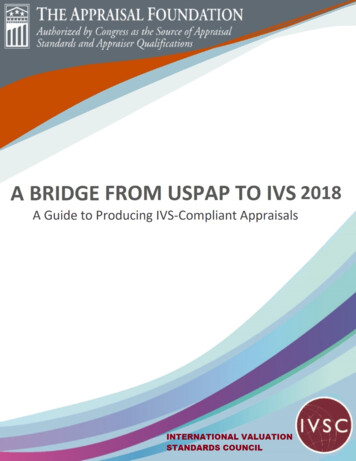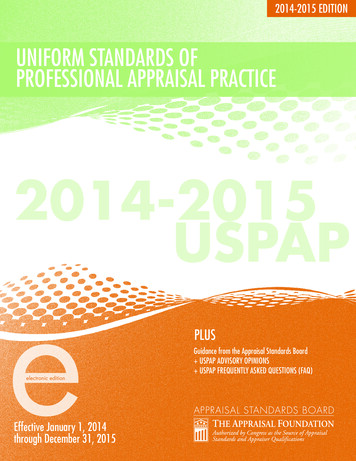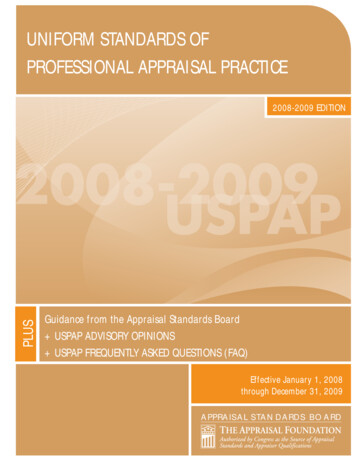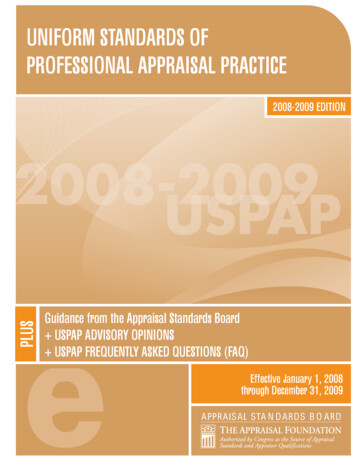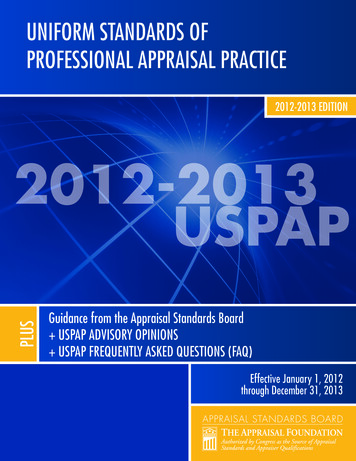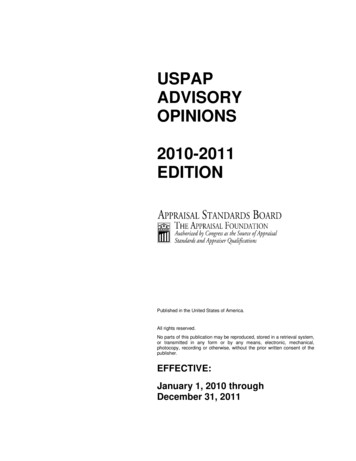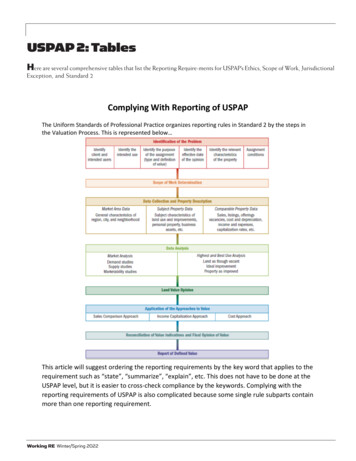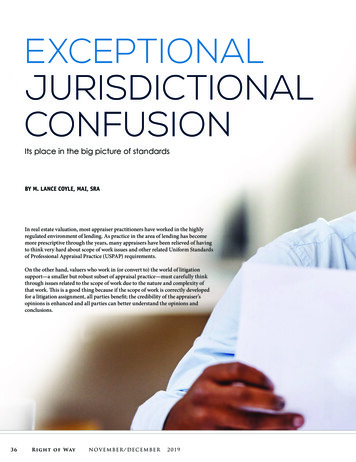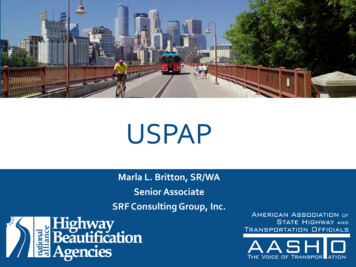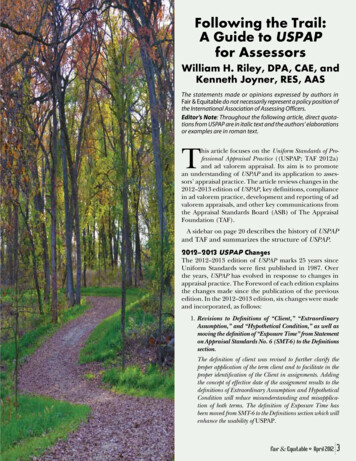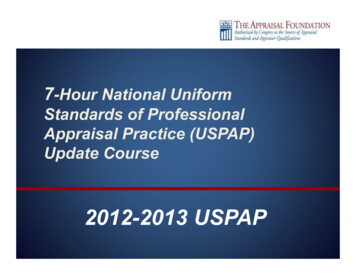
Transcription
7-Hour National UniformStandards of ProfessionalAppraisal Practice (USPAP)Update Course2012-2013 USPAP
PreviewDesignCourse designed to incorporate usage ofthe actual USPAP documentInteractive exercises and real worldproblems are intended to illustrateapplications of USPAP 2012 by The Appraisal Foundation2
Materials You Will NeedStudent ManualUSPAP Document, which includes:1. USPAP2. Advisory Opinions (AO)3. Frequently Asked Questions (FAQ) 2012 by The Appraisal Foundation3
Materials You Will NeedCourse ObjectivesPresent and explain revisions to USPAPeffective Jan 1, 2012 through Dec 31, 2013Present changes to USPAP in a variety ofscenarios for discussionPresent “real world” scenarios thatchallenge participants to interpret andapply USPAP 2012 by The Appraisal Foundation4
AnnouncementsBreak times and lunchRestroom locationsSmoking areasPlease silence your cell phoneRecording is prohibitedBe considerate of those near youAttendance sheetCertificates and evaluation forms 2012 by The Appraisal Foundation5
IntroductionsInstructor Instructor name phone email 2012 by The Appraisal Foundation6
Section OneChanges to USPAP andApplication of the Changes 2012 by The Appraisal Foundation7
Section 1-3Changes to USPAPWhy and How USPAP ChangesA. The ASB develops and submits drafts forpublic exposure1. Exposure Draftsa. Combined result of numerous sourcesb. ASB takes ownership of the language andofficially votes to approve it for release 2012 by The Appraisal Foundation8
Section 1-3Changes to USPAPWhy and How USPAP ChangesA. The ASB develops and submits drafts forpublic exposure (cont’d)2. Comment deadlinesa. Exposure period is not less than 30 daysthough typically 60 days. Visit TAF website:www.appraisalfoundation.orgb. A longer time may be selected for complexdocuments 2012 by The Appraisal Foundation9
Section 1-4Changes to USPAPWhy and How USPAP ChangesB. The ASB analyzes comments received1. All comments are sent to the TAF office inWashington, DC, where a permanent file of allcomments is maintained. All comments aregiven impartial consideration by the ASB2. Each individual submitting a response receivesan acknowledgement of receipt from the staff.Further communication with respondents isoptional at the discretion of the ASB 2012 by The Appraisal Foundation10
Section 1-4Changes to USPAPWhy and How USPAP ChangesB. The ASB analyzes comments received(cont’d)3. Comment letters are read and are valued bythe ASB. A good example of this is the fact thecurrent PREAMBLE was taken almost verbatimfrom a comment letter4. A permanent record of the history of thedrafts, a file of comments received in responseto the exposure draft(s), and other pertinentcorrespondence and reports is maintained 2012 by The Appraisal Foundation11
Section 1-4Changes to USPAPWhy and How USPAP ChangesB. The ASB analyzes comments received(cont’d)5. If changes in the original exposure draft aresubstantial enough to constitute afundamental change in direction, thenconsideration is given to additional exposuredrafts as neededa. Five exposure drafts for 2012-2013b. Postponed COMMUNICATION RULE in ThirdExposure Draft for 2012-2013 2012 by The Appraisal Foundation12
Section 1-5Changes to USPAPWhy and How USPAP ChangesC. The ASB finalizes any changes to USPAP1. Final action on a proposed change may betaken onlya. After the completion of the exposureprocess andb. After discussion and adoption at a publicmeeting2. Once adopted, the changes must be definitiveand cannot contain alternative wordings 2012 by The Appraisal Foundation13
Section 1-5Changes to USPAPIllustration: Process in ActionThe new RECORD KEEPING RULE illustrates how theprocess works. The record keeping issue was brought tothe ASB from several sources. Record Keeping hasbeen a section within the ETHICS RULE for over twodecades. Minor record keeping errors such as nothaving a signed copy of the report in the workfile, couldbe classified as an ETHICS RULE violation. So theRecord Keeping section was moved from the ETHICSRULE to its own rule. Initial feedback was that failure toproperly maintain a workfile should be considered anethical violation. 2012 by The Appraisal Foundation14
Section 1-5Changes to USPAPIllustration: Process in Action(cont’d) The ASB was still concerned thatappraisers might, in some cases, be consideredunethical because of what might be clerical errorsby the appraiser. The ASB then added languageto the ETHICS RULE addressing “willingly andknowingly” violating the RECORD KEEPING RULEin the next draft. After additional feedback, thelanguage in the Fifth Exposure Draft was “willinglyor knowingly,” so that, for enforcement purposes,either would be an ethical violation 2012 by The Appraisal Foundation15
Section 1-5Changes to USPAPRationale of the 2012-2013 ChangesA. DefinitionsChanges were made to three DEFINITIONSand a new definition was added: client,extraordinary assumption, and hypotheticalcondition were revised, and exposure timewas added.Note: As appropriate throughout this sectionof the course, revisions are shown instrikethrough and underscore text 2012 by The Appraisal Foundation16
Section 1-6Changes to USPAPRationale of the 2012-2013 ChangesA. Definitions1. Clienta. Rationale1. Questions and concerns regardingdefinition, particularly with AppraisalManagement Companies2. AMCs were often identified as the clientwhen, in practice AMCs were acting as anagent of a client who initiated the order 2012 by The Appraisal Foundation17
Section 1-6Changes to USPAPRationale of the 2012-2013 ChangesA. Definitions1. Clienta. Rationale (cont’d)3. Guidance is provided in 2012-2013 FAQs116 and 1174. Comment was changed to make it clear anagent may act as a representative of theclient5. Edits were also made to SMT-9 2012 by The Appraisal Foundation18
Section 1-6Changes to USPAPRationale of the 2012-2013 Changesb. Revised definitionCLIENT: the party or parties who engage, anappraiser by employment or contract, an appraiser ina specific assignment.Comment: The client identified by the appraiser inan appraisal, appraisal review, or appraisal consultingassignment (or in the assignment workfile) is theparty or parties with whom the appraiser has anappraiser-client relationship in the relatedassignment, and may be an individual, group, orentity, and may engage and communicate with theappraiser directly or through an agent. 2012 by The Appraisal Foundation19
Section 1-6Changes to USPAPRationale of the 2012-2013 ChangesA. Definitions2. Exposure Timea. Rationale1. The only definition of exposure time wasincluded in SMT-62. The definition is substantially the same andmoving it to the DEFINITIONS enhances theusability of USPAP 2012 by The Appraisal Foundation20
Section 1-7Changes to USPAPRationale of the 2012-2013 Changesb. Revised definitionEXPOSURE TIME: estimated length of time thatthe property interest being appraised wouldhave been offered on the market prior to thehypothetical consummation of a sale at marketvalue on the effective date of the appraisal.Comment: Exposure time is a retrospectiveopinion based on an analysis of past eventsassuming a competitive and open market. 2012 by The Appraisal Foundation21
Section 1-6Changes to USPAPRationale of the 2012-2013 ChangesA. Definitions3. Extraordinary Assumptions and HypotheticalConditionsa. Rationale1. Often misunderstood and misapplied2. Adding the concept of effective datereduces misunderstanding andmisapplication 2012 by The Appraisal Foundation22
Section 1-6Changes to USPAPRationale of the 2012-2013 ChangesA. Definitions3. Extraordinary Assumptions and HypotheticalConditionsa. Rationale (cont’d)3. Additional wording also makes it clear thata Hypothetical Condition is contrary towhat is known to exist on the effective dateof the assignment results 2012 by The Appraisal Foundation23
Section 1-7Changes to USPAPRationale of the 2012-2013 Changesb. Revised definitionEXTRAORDINARY ASSUMPTION: an assumption, directlyrelated to a specific assignment, as of the effective dateof the assignment results, which, if found to be false,could alter the appraiser’s opinions or conclusions.Comment: Extraordinary assumptions presume as factotherwise uncertain information about physical, legal, oreconomic characteristics of the subject property; orabout conditions external to the property, such as marketconditions or trends; or about the integrity of data usedin an analysis. 2012 by The Appraisal Foundation24
Section 1-7Changes to USPAPRationale of the 2012-2013 Changesb. Revised definitionHYPOTHETICAL CONDITION: a condition, directly relatedto a specific assignment, that which is contrary to what isknown by the appraiser to exists on the effective date ofthe assignment results, but is used supposed for thepurpose of analysis.Comment: Hypothetical conditions are assume conditionscontrary to known facts about physical, legal, oreconomic characteristics of the subject property; orabout conditions external to the property, such as marketconditions or trends; or about the integrity of data usedin an analysis. 2012 by The Appraisal Foundation25
Section 1-8Changes to USPAPRationale of the 2012-2013 ChangesB. Revisions relating to development and disclosure ofexposure time1.Rationalea. The reporting requirements in STANDARDS 2, 6, 8, AND 10include the following Comment:Stating the definition of value also requires any commentsneeded to clearly indicate to intended users how thedefinition is being applied.Interpretations of this comment vary. Some think it meansthat when an opinion of exposure time is developed, thatopinion must be reported. Others think that when thereare atypical conditions requiring explanation, thoseconditions, which might include exposure time, must beaddressed. Still others see this Comment as unclear 2012 by The Appraisal Foundation26
Section 1-8Changes to USPAPRationale of the 2012-2013 Changes1. Rationale (cont’d)b. The ASB wanted a clear requirement thatreasonable exposure time must be reported in allassignments in which an opinion must bedevelopedc. While USPAP had requirements for developing anopinion of reasonable exposure time whendeveloping an opinion of market value for realand personal property, the reporting of such anopinion was not clearly specified in the reportingrequirements of STANDARDS 2 (real property) and8 (personal property) 2012 by The Appraisal Foundation27
Section 1-8Changes to USPAPRationale of the 2012-2013 Changes1. Rationale (cont’d)d. Proposed language was suggested as aComment to Standards Rule 7-2(c):Comment: When exposure time is acomponent of the definition for the valueopinion being developed, the appraiser mustalso develop an opinion of reasonableexposure time linked to that value opinion. 2012 by The Appraisal Foundation28
Section 1-9Changes to USPAPRationale of the 2012-2013 Changes1. Rationale (cont’d)e. STANDARD 1 had the requirement that theappraiser, when developing an opinion ofmarket value, also develop an opinion ofreasonable exposure time linked to themarket value opinion. Based on thisdevelopment requirement, inclusion of theexposure time opinion in the report would bethe appropriate means to indicate compliancewith STANDARD 1 2012 by The Appraisal Foundation29
Section 1-9Changes to USPAPRationale of the 2012-2013 Changes1. Rationale (cont’d)f. The Comment of Standards Rule 1-2(c) was editedto require the opinion of reasonable exposuretime whenever it is an element of the definition,regardless of what the type of value is labeledg. Language was added to Standards Rules 2-2(a)(v),2-2(b)(v), and 2-2(c)(v) requiring that the opinionof exposure time, when developed in compliancewith Standards Rule 1-2(c), be stated in the reporth. To add to the overall understandability of USPAP,the definition of exposure time was moved fromSMT-6 and placed in DEFINITIONS in the USPAPdocument 2012 by The Appraisal Foundation30
Section 1-9Changes to USPAPRationale of the 2012-2013 Changes2. ChangesComment:Whendevelopingtoan opinionof marketvalue,the appraisera) TheCommentStandardsRule1-2(c)(iv),asmust also develop an opinion of reasonable exposure time linked to thewell as Standards Rule 7-2(c)(iv), was changedvalue opinion.as follows:Comment: When exposure time is a component of the definition for thevalue opinion being developed, the appraiser must also develop anopinion of reasonable exposure time linked to that value opinion. SeeStatement on Appraisal Standards No. 6, Reasonable Exposure Time inReal Property and Personal Property Market Value Opinions. See alsoAdvisory Opinion 7, Marketing Time Opinions, and Advisory Opinion 22,Scope of Work in Market Value Appraisal Assignments, Real Property 2012 by The Appraisal Foundation31
Section 1-10Changes to USPAPRationale of the 2012-2013 Changes2. Changes (cont’d)c. Only the edits to STANDARD 2 were shownabove; however, corresponding edits werealso made to STANDARD 8d. Revisions, including corresponding edits, weremade to SMT-6 to reflect the changes to theStandards Rules regarding exposure time.Reference is made to SMT 6 in your USPAPdocument 2012 by The Appraisal Foundation32
Section 1-12Changes to USPAPIn the Real World1) I received an appraisal order from anAppraisal Management Company (AMC)which has requested to be identified as theclient in the appraisal report. The AMC willnot provide its client’s name. Does USPAPallow me to identify the AMC as the client ifthe AMC will not disclose the name of itsclient? 2012 by The Appraisal Foundation33
Section 1-12Changes to USPAPIn the Real World2) I was recently asked to perform an appraisalassignment, but the individual thatcontacted my firm was not the client andindicated that the client could not beidentified. Can I accept this assignment andcomply with USPAP? 2012 by The Appraisal Foundation34
Section 1-13Changes to USPAPIn the Real World3) I am completing a market value appraisal. Iuse standard pre-printed residential reportforms that ask for a neighborhood marketingtime. Does marketing time on these formsmean the same thing as exposure time as itis used in USPAP? 2012 by The Appraisal Foundation35
Section 1-13Changes to USPAPIn the Real World4) What is the difference between a client andan intended user? 2012 by The Appraisal Foundation36
Section 1-14Changes to USPAPIn the Real World5) When appraising real property, confusion oftenexists between hypothetical conditions andextraordinary assumptions, and betweenextraordinary assumptions and assumptions.This confusion leads to potential misapplicationin appraisal assignments. Test yourunderstanding of the terms by identifying thefollowing examples as: a) an extraordinaryassumption; b) a hypothetical condition; or c)an assumption. You may want to review thedefinitions of all three first. 2012 by The Appraisal Foundation37
Section 1-14Changes to USPAPIn the Real World5) (cont’d)1. Title to the property is good and marketable2. Appraising a site as if sewer were available whenit is not3. Appraising a site as if the zoning were different4. Appraising a site under an assumed zoning whenthe zoning is not known and there is no evidencethat the assumed zoning is not possible 2012 by The Appraisal Foundation38
Section 1-14Changes to USPAPIn the Real World5) (cont’d)5. Appraising irrigated farmland on the premisewater supply is adequate for irrigated cropproduction, knowing that the existing supply isnot adequate6. Appraising a property as though there were noissues when there is a potential structuralproblem (i.e., crack in a foundation wall) 2012 by The Appraisal Foundation39
Section 1-14Changes to USPAPIn the Real World5) (cont’d)7. Appraising proposed improvements, such as newconstruction or additions, as of the date ofcompletion (a prospective date of value8. Appraising proposed improvements, such as newconstruction or additions, assuming they werecompleted as of a current effective date 2012 by The Appraisal Foundation40
Section 1-15Changes to USPAPIn the Real World6) The Federal Highway Administration (FHWA)publishes a Guide for Preparing an AppraisalScope of Work. One of the items listed isthat the property being acquired should be“appraised as if free and clear ofcontamination,” unless otherwise specified.Is this a jurisdictional exception,extraordinary assumption, or hypotheticalcondition? 2012 by The Appraisal Foundation41
Section 1-15Changes to USPAPIn the Real World7) If I employ a hypothetical condition or anextraordinary assumption in an assignment,does USPAP require me to label it as such? 2012 by The Appraisal Foundation42
Section 1-15Changes to USPAPRationale of the 2012-2013 ChangesC. RECORD KEEPING RULE and related edits to theConduct section of the ETHICS RULE1. Rationale for addition of Rule and related editsa. The appropriateness of having record keepingrequirements located within the ETHICS RULE hasbeen questionedb. While record keeping is important, minorinfractions should not rise to the level of anethical violation. However, deliberate acts thatviolate the record keeping requirements shouldbe seen as ethical violations 2012 by The Appraisal Foundation43
Section 1-16Changes to USPAPRationale of the 2012-2013 ChangesC. RECORD KEEPING RULE and related edits tothe Conduct section of the ETHICS RULE1. Rationale for addition of Rule and edits (cont’d)c. The prohibition against a willful or deliberatefailure to comply with the RECORD KEEPINGRULE has been added to the Conduct sectionof the ETHICS RULE Regardless of how minorerrors originate, appraisers are ultimatelyresponsible for record keeping requirementsd. The changes improve clarity andreasonableness 2012 by The Appraisal Foundation44
Section 1-16Changes to USPAPRationale of the 2012-2013 ChangesC. RECORD KEEPING RULE and related edits tothe Conduct section of the ETHICS RULE2. Changesa. The RECORD KEEPING RULE was added to the2012-2013 edition of USPAP, replacing theprior Record Keeping section of the ETHICSRULEb. The new Rule incorporates parts of the priorRecord Keeping section of the ETHICS RULE,with changes and additions. The new RECORDKEEPING RULE appears on the following page 2012 by The Appraisal Foundation45
Section 1-16Changes to USPAPRationale of the 2012-2013 ChangesC. RECORD KEEPING RULE and related edits toAn appraiser:theConduct section of the ETHICS RULE2. mustChangesnot willfully or knowingly violate the requirements of theRECORD KEEPING RULE;c. The prohibition against a willful or deliberatefailurecomplywithfailstheRECORDKEEPINGAn appraiserwhotowillfullyor knowinglyto complywith theobligations ofthis RECORD KEEPING RULE is in violation of the ETHICS RULE.RULE was added to the Conduct section of theETHICS RULE. Reference is made to the USPAPdocument for the entire rule. The additionalprohibition states 2012 by The Appraisal Foundation46
Section 1-18Changes to USPAPRationale of the 2012-2013 ChangesC. RECORD KEEPING RULE and related edits tothe Conduct section of the ETHICS RULE2. Changesd. With the adoption of the RECORD KEEPINGRULE, edits to Standards Rules 2-4, 3-7, 5-4,8-4, and 10-4 were required 2012 by The Appraisal Foundation47
Section 1-18Changes to USPAPRationale of the 2012-2013 ChangesD. Revisions to Standards Rules 2-3, 3-6, 5-3, 6-9, 83, and 10-3, addressing prior services in thereport certification1. Rationale for revisiona. In the 2010-2011 edition of USPAP, prior serviceswere to be addressed in the certification onlywhen the appraiser had provided them within therelevant time frameb. Conversely, in the same edition of USPAP, theappraiser must disclose either the presence orabsence of any current or prospective interestregarding the subject or the parties involved 2012 by The Appraisal Foundation48
Section 1-18Changes to USPAPRationale of the 2012-2013 ChangesD. Revisions to Standards Rules 2-3, 3-6, 5-3, 69, 8-3, and 10-3, addressing prior services inthe report certification1. Rationale for revision (cont’d)c. Confusion among appraisers and users ofappraisal services exists with respect todisclosing and reporting a prior serviced.d. To improve consistency and help reduce clientquestions, an addition has been made to thecertification regarding prior services 2012 by The Appraisal Foundation49
Section 1-18Changes to USPAPRationale of the 2012-2013 ChangesD. Revisions to Standards Rules 2-3, 3-6, 5-3, 62-3, 5-3,6-9, 10-3,8-3, and 10-3:9,SR8-3,andaddressing prior services inI have performed no (or the specified) services, as an appraiser or inthereportcertificationany othercapacity,regarding the property that is the subject of thiswithin the three-year period immediately preceding acceptance2. reportChangesof this assignment.a. The following addition has been made to theSR 3-6:certifications for Standards Rule 2-3, 3-6, 5-3,I have performed no (or the specified) other services, as an appraiser6-9,8-3,and regarding10-3. the property that is the subject ofor in anyothercapacity,the work under review within the three-year period immediatelypreceding acceptance of this assignment. 2012 by The Appraisal Foundation50
Section 1-19Changes to USPAPIn the Real World1) If I have appraised a property multiple timeswithin the previous three years, do I have todisclose the number of appraisal services?(e.g., “I have appraised the subject propertythree times during the previous threeyears.”) 2012 by The Appraisal Foundation51
Section 1-19Changes to USPAPIn the Real World2) If I have performed a service other thanappraisal practice, such as acting as a generalcontractor within the prior three years, do Ihave to describe the specific service ormerely state a service was performed? 2012 by The Appraisal Foundation52
Section 1-20Changes to USPAPIn the Real World3) The Comment to the Conduct section of theETHICS RULE states, in part, “If an appraiserhas agreed with a client not to disclose thathe or she has appraised a property, theappraiser must decline all subsequentassignments that fall within the three-yearperiod.” Does this really mean that theappraiser could not be engaged by this sameclient, on this property, within the thee-yearperiod? 2012 by The Appraisal Foundation53
Section 1-20Changes to USPAPIn the Real World4) I am aware of the disclosure requirements inthe Conduct section of the ETHICS RULE thatrequires me to disclose any services Iperformed regarding the subject propertywithin the prior three years. If I have notperformed any such services, am I requiredto make that disclosure as well? 2012 by The Appraisal Foundation54
Section 1-21Changes to USPAPIn the Real World6) How must recognition of my significantappraisal assistance be included when thereis no written report, but significantassistance was provided and documentationof my work is in the workfile? 2012 by The Appraisal Foundation55
Section 1-22Changes to USPAPIn the Real World7) I am aware of and comply with the workfileretention requirements in the RECORDKEEPING RULE in USPAP. However, once therequired retention period has passed, doesUSPAP dictate a method I must employ todispose of the workfiles? 2012 by The Appraisal Foundation56
Section 1-22Changes to USPAPIn the Real World8) The RECORD KEEPING RULE states, in part:The workfile must include true copies of anywritten reports Does a true copy have toinclude a signature on the certification? 2012 by The Appraisal Foundation57
Section 1-23Changes to USPAPRationale of the 2012-2013 ChangesE. Revisions to STANDARDS 7 and 8: PersonalProperty Appraisal, Development andReporting1. Rationale for revising STANDARDS 7 and 8a. The personal property community indicatedthat STANDARDS 7 and 8 did not use personalproperty terminology and, in some cases, didnot reflect current practice within thepersonal property discipline 2012 by The Appraisal Foundation58
Section 1-23Changes to USPAPRationale of the 2012-2013 ChangesE. Revisions to STANDARDS 7 and 8: PersonalProperty Appraisal, Development and Reporting1. Rationale for revising STANDARDS 7 and 8 (cont’d)b. STANDARDS 7 and 8 had not beencomprehensively reviewed for several yearsc. A Personal Property Task Force (PPTF) wasappointed and made numerous recommendationsto the ASB, resulting in significant changes toSTANDARD 7 2012 by The Appraisal Foundation59
Section 1-23Changes to USPAPRationale of the 2012-2013 Changes2. Changesa. STANDARD 7 has changed significantly. Many ofthe changes present language that is moreconsistent with that used by personal propertyappraisers. However, some of the changes have amore significant effect on acceptableperformanceb. Personal property can have multiple market andmultiple uses, and is largely portable in nature.Therefore, Standards Rule 7-3(a) was changed toeliminate the language that is typically associatedwith highest and best use to be more consistentwith the vocabulary and practices of the personalproperty appraiser 2012 by The Appraisal Foundation60
Section 1-23Changes to USPAPRationale of the 2012-2013 Changes2. Changesc. Personal property appraisals frequently involvemultiple objects in a single appraisal assignment,and the value significance of these objects canvary greatly. Standards Rule 7-4(e) was changedto specify that objects which are more significantto the assignment results should be the focus ofthe analysisd. Wording in Standards Rule 7-5 was changed. TheRule now requires the analysis of prior sales thatoccurred within a reasonable and applicable timeperiod, if relevant given the intended use of theappraisal and property type. 2012 by The Appraisal Foundation61
Section 1-24Changes to USPAPRationale of the 2012-2013 Changes2. Changese. Edits were made to STANDARD 8 consistentwith changes to STANDARD 2 and the otherreporting standards regarding the reporting ofexposure time, the labeling of hypotheticalconditions, the RECORD KEEPING RULE, andthe revised certificationf. It is important to reference STANDARDS 7 and8 in their entirety because of the extensiveupdating and revising to both 2012 by The Appraisal Foundation62
Section 1-24Changes to USPAPRationale of the 2012-2013 ChangesF. Revisions to Advisory Opinion 21, USPAPCompliance1. Rationale for revisinga. Requests were received from appraisers,appraisal clients, and state appraisalregulatory officials for additional clarificationand additional illustrative examples inAdvisory Opinion 21, USPAP Complianceb. The addition of the new RECORD KEEPINGRULE necessitated, in part, some edits andenhancements to the Advisory Opinion 2012 by The Appraisal Foundation63
Section 1-24Changes to USPAPRationale of the 2012-2013 ChangesF. Revisions to Advisory Opinion 21, USPAPCompliance2. Changesa. The illustrations in AO-21 were reviewed andupdated or replaced as necessary to providerelevant guidance regarding when USPAP applies.b. Other edits were made as necessaryc. Reference is made to AO-21 in the USPAPdocument under the Advisory Opinions tab forthe full content of the revised Advisory Opinion 2012 by The Appraisal Foundation64
Section 1-24Changes to USPAPRationale of the 2012-2013 ChangesG. Other changes to USPAP1. Appropriate edits were made throughout USPAPto reflect the changes2. No STATEMENTS were added or deleted for2012-2013. As appropriate, STATEMENTS wereedited for consistency with changes to the USPAPdocument3. No Advisory Opinions were added and nonewere deleted for 2012-2013. 2012 by The Appraisal Foundation65
Section 1-25Changes to USPAPRationale of the 2012-2013 ChangesG. Other changes to USPAP4. Guidance was removed from Advisory Opinion 13(AO-13), Performing Evaluations of Real PropertyCollateral to Conform with USPAP, for the 2012-2013edition of the USPAP document. The guidelinesoffered in AO-13 were superseded by revisedInteragency Appraisal and Evaluation Guidelinesissued on December 2, 2010. As a result, the ASBwill be working with the Interagency Work Group toupdate AO-13 to provide meaningful guidance onthis more recent edition of the guidelines. 2012 by The Appraisal Foundation66
Section 1-25Changes to USPAPRationale of the 2012-2013 ChangesG. Other changes to USPAP4. Advisory Opinion 13 (AO-13) (cont’d)a. The ASB intends to expose proposed revisionsto AO-13 as soon as possible, and expects toissue an updated version of AO-13 prior to theeffective date of the next edition of USPAP(January 1, 2014)b. Appraisers, in the interim, are urged to reviewthe revised guidelines on The AppraisalFoundation’s website 2012 by The Appraisal Foundation67
Section 1-26Changes to USPAPIn the Real World1) Robert Agent is an individual who providesboth brokerage and appraisal services. Whatare Robert’s obligations under USPAP whenpreparing a broker’s price opinion (BPO)? 2012 by The Appraisal Foundation68
Section 1-26Changes to USPAPIn the Real World2) A client has asked Mike Black to perform arent survey. The client owns the Acme OfficeBuilding and wants to know if he is chargingenough rent. The client asked Mike toperform this work because he knows Mike isan appraiser; therefore, this valuation serviceis included in appraisal practice and USPAPapplies. How can Mike provide this servicein compliance with USPAP? 2012 by The Appraisal Foundation69
Section 1-27Changes to USPAPIn the Real World3) Dan Williams is an appraiser. He was askedby a client to perform an “administrativescreening review” of an appraisal report todetermine if a more thorough review iswarranted. The client would like Dan tocheck the math calculations and determinewhether the appraisal report complies withthe client’s basic content specifications.What are Dan’s obligations under USPAP? 2012 by The Appraisal Foundation70
Section 1-27Changes to USPAPIn the Real World4) Marie Vaughn has a diverse practice thatincludes specialized litigation services. Shecommonly aids attorneys in developingcr
Changes to USPAP 1. Rationale (cont’d) b. The ASB wanted a clear requirement that reasonable exposure time must be reported in all assignments in which an opinion must be developed c. While USPAP had requirements for developing an opinion of reasonable exposure
